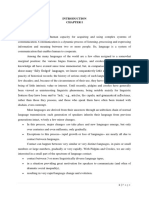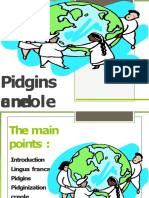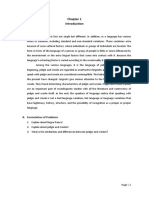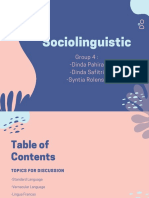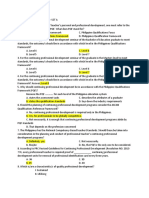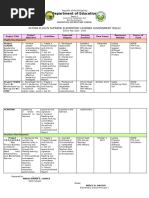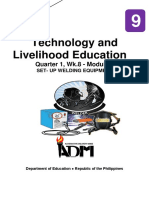0 ratings0% found this document useful (0 votes)
24 views16-Creation of Creoles
16-Creation of Creoles
Uploaded by
dkoeyjPidgins and creoles develop in contact situations where language groups need to communicate but don't share a common language. [1] Pidgins have limited functions and no native speakers, arising to enable trade between groups. [2] Some pidgins expand and become the native language of children, creating a creole with its own grammar rules. [3] Creolization involves major expansion of a language's structural resources as it shifts from a secondary to primary language.
Copyright:
© All Rights Reserved
Available Formats
Download as PPT, PDF, TXT or read online from Scribd
16-Creation of Creoles
16-Creation of Creoles
Uploaded by
dkoeyj0 ratings0% found this document useful (0 votes)
24 views25 pagesPidgins and creoles develop in contact situations where language groups need to communicate but don't share a common language. [1] Pidgins have limited functions and no native speakers, arising to enable trade between groups. [2] Some pidgins expand and become the native language of children, creating a creole with its own grammar rules. [3] Creolization involves major expansion of a language's structural resources as it shifts from a secondary to primary language.
Copyright
© © All Rights Reserved
Available Formats
PPT, PDF, TXT or read online from Scribd
Share this document
Did you find this document useful?
Is this content inappropriate?
Pidgins and creoles develop in contact situations where language groups need to communicate but don't share a common language. [1] Pidgins have limited functions and no native speakers, arising to enable trade between groups. [2] Some pidgins expand and become the native language of children, creating a creole with its own grammar rules. [3] Creolization involves major expansion of a language's structural resources as it shifts from a secondary to primary language.
Copyright:
© All Rights Reserved
Available Formats
Download as PPT, PDF, TXT or read online from Scribd
Download as ppt, pdf, or txt
0 ratings0% found this document useful (0 votes)
24 views25 pages16-Creation of Creoles
16-Creation of Creoles
Uploaded by
dkoeyjPidgins and creoles develop in contact situations where language groups need to communicate but don't share a common language. [1] Pidgins have limited functions and no native speakers, arising to enable trade between groups. [2] Some pidgins expand and become the native language of children, creating a creole with its own grammar rules. [3] Creolization involves major expansion of a language's structural resources as it shifts from a secondary to primary language.
Copyright:
© All Rights Reserved
Available Formats
Download as PPT, PDF, TXT or read online from Scribd
Download as ppt, pdf, or txt
You are on page 1of 25
Creation of Pidgins and
Creoles
Lahore Leads University
Introduction to PIDGINS
PIDGIN
• arises in a (new) contact situation involving more
than two linguistic groups
• groups have no shared language
• groups need to communicate regularly, but for
limited purposes, such as trade
• is nobody's native language
• vocabulary (typically) from one of the Langua-ges (=
Lexifier Language)
• grammar is a kind of cross language compromi-se
with influence from universals of L2 learning
• no elaborate morphological structures
Pidgins
Limited functions (esp. trade)
No native speakers (nobody’s mother tongue)
Contact language involving at least two, often three
different language groups
That is, it is the product of a multilingual situation in
which those who wish to communicate must find or
improvise a simple language system that will enable
them to do so.
Pidgin Origins
So Pidgins, in the stereotypical case, are formed when
speakers of one language engage in trade with speakers of
another, or work on plantations managed by speakers of
another, and neither knows the other’s language.
In plantation settings, their manual function is to enable
workers to communicate with each other, since plantation
laborers very often do not speak the same language.
Expanded Pidgins
Pidgins usually have limited life-span; can die out when
the interactions that they serve end (e.g., the end of a trade
route)
Pidgins will survive longer if at least two language groups
are involved.
E.g. Non-European language groups not in frequent
contact with each other until arrival of trans-oceanic trade
will continue to use the Pidgin created.
Expanded Pidgins
So the pidgin becomes a link language among the non-
Europeans, who sometimes continue to develop and use
it after the Europeans have left
True in many West African countries and South Pacific
islands (e.g., Sierra Leone in Story of English).
So it can become an expanded pidgin, like the Nigerian
pidgin Genesis, and remain in wide use.
Grammar and vocabulary expand as types of interaction
become broader and more complex.
But still no native speakers.
Expanded Pidgins
However, under certain circumstances, expanded pidgins
can start to have native speakers
Imagine that as trade along the rivers and the coastal areas
continues to expand,
Communities (ultimately cities) develop in which speakers
of different non-European languages interact frequently for
many purposes
The only language that they share is the pidgin
If woman and man from different native language
backgrounds meet frequently and eventually marry, they
can only communicate with each other in the pidgin.
Expanded Pidgins
What happens when they have children? What language
will the children speak?
Thechildren will be native speakers of the pidgin, and
they will grow up with other children having similar
language backgrounds.
As they grow up and become involved in broad range of
activities (education, music, religion), their language
becomes more complex in terms of grammar, vocabulary,
and discourse.
Lifecycles of Pidgins
Jargon Phase: contains great
individual variation
Stable Pidgin: contains both
simple and complex sentences
Expanded Pidgin: complex
grammar, and has a developed
word formation component
Features of a Stable Pidgin
Lack of surface grammatical complexity
Lack of morphological complexity
Semantic transparency
Vocabulary reduction
Creoles
Thus,
-A Creole is often defined as a pidgin that has become the
first language of a new generation of speakers, i.e. creoles
arise when pidgins become mother tongues.
- A creole, therefore, is a ‘normal’ language in almost every
sense.
- A Creole is a pidgin which has expanded in structure and
vocabulary to express the range of meanings and serve the
range of functions required of a first language.
From Pidgins To Creoles
When a pidgin has become nativized, the history of the
resultant Creoles is, in essence, similar to that of any
other language.
Hence, whereas a pidgin is identifiable at any given time
by both linguistic and social criteria, a Creole is
identifiable only by historical criteria—that is if we know
that it has arisen out of pidgin.
There are no structural criteria which, in themselves, will
identify a Creole as such, in the absence of historical
evidence.
CREOLES
Creole
• arises in a (new) contact situation involving more than two
linguistic groups
• is the native language of
a speech community
• vocabulary (typically) from one of the Languages (= Lexifier
Language)
• grammar is a kind of crosslanguage compromise with influence
from universals of L2 learning
• some creoles are nativized pidgins
Definition of a Creole
Creole: a second-generation language spoken by
children who grow up in a pidgin community.
Creole – Created by the children of pidgin speakers
with its own grammar. A common primary means
of communication (not just for trade, and not
secondary, like pidgins) in situations where the
speakers in contact are in need of communication
History of the word ‘Creole’
• from Latin creare (to create), Portuguese criar (to nurse)
• Portuguese, Spanish and French colonies in the New
World: a noun from this word meant ‘a person or animal
born in the home’ (Fr. creole)
• Caribbean usage in 17th-18th centuries, creole meant:
A local descendant of European settlers (white creole, creole
white)
Descendant of African slaves (Negro creole, creole Negro)
A mixture of both, usually capitalized (the local Creoles, the
local Creole population)
• extended to Louisiana
• late 19th century, creole extended to languages
throughout colonial and postcolonial tropics, all
over the world (Americas, Australasia, Indian
Ocean, elsewhere)
• French Creole, Creole French (Martinique,
Mauritius)
• English Creole, Creole English (Belize, Jamaica)
• Roper River Creole (Australia)
• Hawaii Creole English (Pacific)
• people of any background in a place where a creole
is used are likely to speak, whether or not it is their
mother tongue
• creoles are acquired as a first language by children
• speech becomes faster, vocabulary increaes,
development of tenses increases, development of
relative clauses increases
Theories of Creolization
1. When children learn a pidgin as a native
language
2. Grammaticalization and phrases become
words ‘ma bilong mi’ (my husband) to mabilongmi
(Wardhaugh 78)
Levels of creole/language status
and the continuum
1. Acrolect “high speech”
2. Mesolect “middle speech”
3. Basolect “low speech”
Groups often recognize status distinctions subconsciously
Creolization
1. When children learn a pidgin as their mother
tongue, within a generation or two, native
language use becomes consolidated and
widespread. The result is a creole.
2.Major expansion in the structural linguistic
resources: vocabulary, grammar, and style.
3.Shift in the overall patterns of language use in
the community.
Decreolization
Shifttoward standard form of the
language from which the creole derives.
The standard language has the status of
social prestige, education, wealth. Creole
speakers find themselves under great
pressure to change their speech in the
direction of the standard.
Hypercreolization
◦ Aggressive reaction against the standard
language on the part of creole speakers, who
assert the superior status of their creole, and
the need to recognize the ethnic identity of
their communication. Such a reaction can
lead to a marked change in speech habits as
speakers focus on what they see as the
“pure” form of the creole.
Recreolization
As Jamacians living in England who
“deliberately recreolize the English they use
in an attempt to assert their ethnic identity
and solidarity bacause of the social situation
in which they find themselves (Wardhaugh
84)
What is it?
Pidgin:
Creole
Simplified
A language that was
language between
two or more originally a pidgin
different groups of but bacame an official
people (that don’t language.
speak the same
language). Most vocabulary
Pidgin doesn’t last originates from parent
unless it becomes a language.
creole. Has its own
Vocabulary derives
from one of the grammatical set of
languages. rules.
No grammatical
When and where is it used?
Pidgin
Creole
Used when two people
Used as a language at
with different
languages need to homes and schools.
communicate with A language that a
each other community knows
E.g. African slaves Can be an official
from different regionslanguage
created a pidgin
What’s the difference?
Creoles
IS a mother
tongue
Larger
vocabulary
Greater
linguistic
range,
capable of
Crucial Difference: Pidgins have no native speakers, while Creole
being spoken
quicker
You might also like
- CBSE Class 3 Mathematics Worksheet (48) - DivisionDocument5 pagesCBSE Class 3 Mathematics Worksheet (48) - DivisionSuyamshree Behuria90% (10)
- Family Climate ScaleDocument2 pagesFamily Climate Scalejosef mercado86% (7)
- Ordinary People Family AssessmentDocument12 pagesOrdinary People Family AssessmentFLUTURA MUSTAA100% (2)
- Anthropology Learning in Childhood PDFDocument497 pagesAnthropology Learning in Childhood PDFKristi Susanti100% (1)
- John H. Goldthorpe - Sociology As A Population Science-Cambridge University Press (2015)Document161 pagesJohn H. Goldthorpe - Sociology As A Population Science-Cambridge University Press (2015)Bárbara Estévez LestonNo ratings yet
- Formal and Informal LanguageDocument5 pagesFormal and Informal LanguageNguyen Thi Ngoc Hanh100% (1)
- Pidgin and Creole LanguagesDocument12 pagesPidgin and Creole Languagesresaarsita0106No ratings yet
- EL 101: Language, Culture and SocietyDocument6 pagesEL 101: Language, Culture and SocietyTeacherMhurzNo ratings yet
- Some Disagreement: 2. Difference Between Pidgin and CreoleDocument6 pagesSome Disagreement: 2. Difference Between Pidgin and CreolemansanaskoNo ratings yet
- Lecture 7 Ling L2 S2Document23 pagesLecture 7 Ling L2 S2hafsibahdja2No ratings yet
- Pidgin and CreoleDocument1 pagePidgin and CreoleJcca Jms TokiroiNo ratings yet
- Pidgin and Creole Languages (Relationships, Origins and Characteristics)Document5 pagesPidgin and Creole Languages (Relationships, Origins and Characteristics)Sanja AjdukovićNo ratings yet
- Pidgins and Creoles SorokinaDocument2 pagesPidgins and Creoles SorokinaНик СайбергNo ratings yet
- Yanky Rimawan - PB4ADocument3 pagesYanky Rimawan - PB4AYanky RimawanNo ratings yet
- Bsee 22 Module 4Document3 pagesBsee 22 Module 4Kristine Bernadette NuestroNo ratings yet
- Pidgin and Creole LanguageDocument5 pagesPidgin and Creole LanguageTwinkle SoniNo ratings yet
- Pidgins and Creoles An OverviewDocument3 pagesPidgins and Creoles An OverviewMotion HeroNo ratings yet
- pidgens and creolesDocument1 pagepidgens and creolesmunawarshah9686No ratings yet
- Pidgin and CreoleDocument21 pagesPidgin and CreoleTargetNo ratings yet
- Mixture of VarietiesDocument4 pagesMixture of VarietiesWasim Malik100% (2)
- From Pidgin To Creole LanguageDocument18 pagesFrom Pidgin To Creole LanguageNoor Khan100% (1)
- 9b. CreoleDocument14 pages9b. Creoleshakeelkhanturlandi5No ratings yet
- Pidgins and CreolesDocument5 pagesPidgins and CreolesLydia LopezNo ratings yet
- Pidgins and CreoleDocument15 pagesPidgins and CreoleRizky Eka PrasetyaNo ratings yet
- Pidgin and Creole LanguagesDocument5 pagesPidgin and Creole LanguagesOthmanYusofNo ratings yet
- Linguistic Varieties and Multilingual Nations: Ada Berfin Yıldız Merve Şevval Kurt Ayşe Sena ÖzenDocument30 pagesLinguistic Varieties and Multilingual Nations: Ada Berfin Yıldız Merve Şevval Kurt Ayşe Sena ÖzenAda YıldızNo ratings yet
- Pidgins and CreolesDocument2 pagesPidgins and CreolesJuan Carlos Solís RiveraNo ratings yet
- Topic: Pidgin and Creole: Sobia KaleemDocument2 pagesTopic: Pidgin and Creole: Sobia KaleemMia StangerNo ratings yet
- Code switchingDocument8 pagesCode switchingrahulabu3No ratings yet
- Sociolinguistic: - Diglossia - Language Planning - Pidgin - Creole - BilingulismDocument19 pagesSociolinguistic: - Diglossia - Language Planning - Pidgin - Creole - BilingulismNoor KhanNo ratings yet
- Pidgin and Creole LanguagesDocument3 pagesPidgin and Creole LanguagesShakira EnnNo ratings yet
- Pidgins and CreolesDocument26 pagesPidgins and CreolesA Vera DltNo ratings yet
- Sociolinguistics 4Document18 pagesSociolinguistics 4fatima zahra SoulaimaniNo ratings yet
- Assignment - 1 SociolinguisticsDocument15 pagesAssignment - 1 SociolinguisticsSyed Asim Raza80% (5)
- Lesson 11 - GLDocument24 pagesLesson 11 - GLDanilagidNo ratings yet
- Language ContactDocument3 pagesLanguage Contactbilalmellah.engNo ratings yet
- Differences Between Pidgins and CreolesDocument5 pagesDifferences Between Pidgins and CreolesDorepe IconNo ratings yet
- Makalah Sociolinguistics (Pidgin and Creole) 2Document13 pagesMakalah Sociolinguistics (Pidgin and Creole) 2Lita Trii Lestari100% (1)
- Pidgin and CreolesDocument2 pagesPidgin and CreolesDeka100% (1)
- SocioDocument23 pagesSocioHasanNo ratings yet
- Makalah Pidgin and CreolesDocument10 pagesMakalah Pidgin and Creolesalyssa ayuningtyas100% (1)
- Pidgins and CreolesDocument7 pagesPidgins and CreolesAtiq Aslam100% (1)
- Pidgin and Creole SummaryDocument2 pagesPidgin and Creole SummaryHafsah NoorNo ratings yet
- Language Contact: Lingua Franca, Pidgin, CreoleDocument9 pagesLanguage Contact: Lingua Franca, Pidgin, CreoleByozdeNo ratings yet
- Edited Guide Entry: Pidgins and CreolesDocument6 pagesEdited Guide Entry: Pidgins and CreolesShinta Ari HerdianaNo ratings yet
- Lecture11bHandout LgContactDocument3 pagesLecture11bHandout LgContactJenniferNo ratings yet
- Pidgins and CreolesDocument23 pagesPidgins and CreolesHasanNo ratings yet
- 6.1-Pidgins and CreolesDocument4 pages6.1-Pidgins and CreolesMd. Ajijul IslamNo ratings yet
- Regional and Non-Regional Accents (Pidgins Creoles, Bilingualism)Document80 pagesRegional and Non-Regional Accents (Pidgins Creoles, Bilingualism)Federica BellinaNo ratings yet
- Lingua Franca, Pidgin, CreoleDocument10 pagesLingua Franca, Pidgin, CreoleSintha Dewi Juni Fatmawati100% (3)
- Socio Linguistic PDFDocument26 pagesSocio Linguistic PDFDinda Pahira MNo ratings yet
- Lyra Virna-2269010404'paper'Document12 pagesLyra Virna-2269010404'paper'Lyra VirnaNo ratings yet
- Chapter 4Document3 pagesChapter 4Baskhoro Edo PrastyoNo ratings yet
- 4 EfendiDocument9 pages4 EfendiRubina SaffieNo ratings yet
- Varieties in EnglishDocument14 pagesVarieties in EnglishzelenavilaNo ratings yet
- Lingua Francas Pidgins and Creoles PetrovaDocument8 pagesLingua Francas Pidgins and Creoles Petrovapetrova.valeria19.02No ratings yet
- CreolizationDocument1 pageCreolizationLourdes LedesmaNo ratings yet
- Difference Between Pidgin and CreoleDocument7 pagesDifference Between Pidgin and CreoleMaick Nova100% (1)
- Linguistic Varieties and Multilingual NationsDocument3 pagesLinguistic Varieties and Multilingual NationsTheofany SabtiandyNo ratings yet
- Continuation of Lesson 2 VARIETIES AND REGISTERS OF SPOKEN AND WRITTEN LANGUAGEDocument14 pagesContinuation of Lesson 2 VARIETIES AND REGISTERS OF SPOKEN AND WRITTEN LANGUAGEJEMIMA RUTH MARANo ratings yet
- A Language With Multiple OriginsDocument2 pagesA Language With Multiple OriginsShang MarieNo ratings yet
- Final Test Subject: Sociolinguistics Lecturer: Dr. H. Pauzan, M. Hum. M. PDDocument25 pagesFinal Test Subject: Sociolinguistics Lecturer: Dr. H. Pauzan, M. Hum. M. PDAyudia InaraNo ratings yet
- Tugas Presentasi TGL 28Document13 pagesTugas Presentasi TGL 28Harits Bima NugrahaNo ratings yet
- What Is Creole Language - Definition & PhrasesDocument2 pagesWhat Is Creole Language - Definition & PhrasesGabriel7496No ratings yet
- Lecture #4Document7 pagesLecture #4eghriebNo ratings yet
- The Undiscovered Self - Carl Gustav JungDocument25 pagesThe Undiscovered Self - Carl Gustav JungYusuf IrawanNo ratings yet
- DLL - MTB 3 - Q3 - W2Document4 pagesDLL - MTB 3 - Q3 - W2RHEA L. CATUGONo ratings yet
- Proiect Didactic 2Document4 pagesProiect Didactic 2Crăciun AlinaNo ratings yet
- 2024 Product Management TrendsDocument2 pages2024 Product Management TrendsGopinathNo ratings yet
- Course IntroductionDocument22 pagesCourse Introductiondangnhhe180564No ratings yet
- English 10: Quarter Iv IV1Document5 pagesEnglish 10: Quarter Iv IV1Jenifer PraycoNo ratings yet
- 10 1108 - Jieb 07 2020 0060Document18 pages10 1108 - Jieb 07 2020 0060TamerZakiFouadNo ratings yet
- Introduction To Stokoe NotationDocument15 pagesIntroduction To Stokoe NotationbenusibNo ratings yet
- Prof Ed QuestionsDocument6 pagesProf Ed QuestionsKazumi Welhemsen100% (1)
- Human Resource Management: Middlesex University Business School, Hong KongDocument4 pagesHuman Resource Management: Middlesex University Business School, Hong KongKelly CarrollNo ratings yet
- Detailed Lesson Plan Grade 3-Art (1 Quarter) I. ObjectivesDocument4 pagesDetailed Lesson Plan Grade 3-Art (1 Quarter) I. ObjectivesRoy JavillaNo ratings yet
- Bao Et Al 2008Document13 pagesBao Et Al 2008Lucas RibeiroNo ratings yet
- UpGrad Campus - Business Analytics BrochureDocument12 pagesUpGrad Campus - Business Analytics Brochurematej24304No ratings yet
- 3 Velocity Exercises 6 - Answer Sheet 2Document2 pages3 Velocity Exercises 6 - Answer Sheet 2zgd8kfz85jNo ratings yet
- Balane DLP TTPDocument4 pagesBalane DLP TTPgabriel.balane27No ratings yet
- Tel 410 l1 Assignment - Signature Assignment - Advocacy Plan - Part 1Document6 pagesTel 410 l1 Assignment - Signature Assignment - Advocacy Plan - Part 1api-437254424No ratings yet
- HenatiDocument17 pagesHenatiSheryn CredoNo ratings yet
- Of Mice and MenDocument19 pagesOf Mice and Menapi-547122614No ratings yet
- ACTION PLAN SELG FinalDocument2 pagesACTION PLAN SELG FinaldivinasartoNo ratings yet
- Technology and Livelihood Education: Quarter 1, Wk.8 - Module 2Document43 pagesTechnology and Livelihood Education: Quarter 1, Wk.8 - Module 2Mary Jean MagdayNo ratings yet
- Bachman Chapter 3Document35 pagesBachman Chapter 3Leyla100% (1)
- ESCP-Business-School Master-In-ManagementDocument23 pagesESCP-Business-School Master-In-ManagementLiu LysNo ratings yet
- CEE 366 Syllabus & ScheduleDocument4 pagesCEE 366 Syllabus & ScheduleDylan Raye-LeonardNo ratings yet
- Declarative and Interrogative Sentences: Because of Winn-DixieDocument4 pagesDeclarative and Interrogative Sentences: Because of Winn-DixieLUSI0% (1)





































